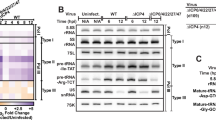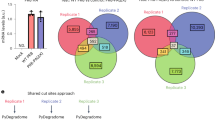Abstract
Transcription start sites are critical switches for converting recognition of chromosomal DNA into active synthesis of RNA. Their functional importance suggests that they may be ideal targets for regulating gene expression. Here, we report potent inhibition of gene expression by antigene RNAs (agRNAs) complementary to transcription start sites within human chromosomal DNA. Silencing does not require methylation of DNA and differs from all known mechanisms for inhibiting transcription. agRNAs overlap DNA sequences within the open complex formed by RNA polymerase, and silencing is acutely sensitive to single base shifts. agRNAs effectively silence both TATA-less and TATA-box-containing promoters. Transcription start sites occur within every gene, providing predictable targets for agRNAs. Potent inhibition of multiple genes suggests that agRNAs may represent a natural mechanism for controlling transcription, may complement siRNAs and miRNAs that target mRNA, and will be valuable agents for silencing gene expression.
This is a preview of subscription content, access via your institution
Access options
Subscribe to this journal
Receive 12 print issues and online access
$259.00 per year
only $21.58 per issue
Buy this article
- Purchase on Springer Link
- Instant access to full article PDF
Prices may be subject to local taxes which are calculated during checkout





Similar content being viewed by others
References
Elbashir, S.M. et al. Duplexes of 21-nucleotide RNAs mediate RNA interference in mammalian cell culture. Nature 411, 494–498 (2001).
Matzke, M.A. & Birchler, J.A. RNAi-mediated pathways in the nucleus. Nat. Rev. Genet. 6, 24–35 (2005).
Chan, S.W. et al. RNA silencing genes control de novo DNA methylation (2004). Science 303, 1336 (2004).
Sugiyama, T., Cam, H., Verdel, A., Moazed, D. & Grewal, S.I.S. RNA-dependent RNA polymerase is an essential component of a self enforcing loop coupling heterochromatin assembly to siRNA production. Proc. Natl. Acad. Sci. USA 102, 152–157 (2005).
Sigova, A., Rhind, N. & Zamore, P.D. A single argonaute protein mediates both transcriptional and posttranscriptional silencing in Schizosaccharomyces pombe. Genes Dev. 18, 2359–2367 (2004).
Motamedi, M.R. et al. Two RNAi complexes, RITS and RDRC, physically interact and localize to noncoding centromeric RNAs. Cell 119, 789–802 (2004).
Kawasaki, H. & Taira, K. Induction of DNA methylation and gene silencing by short interfering RNAs in human cells. Nature 431, 211–217 (2004).
Morris, K.V., Chan, S.W., Jacobsen, S.E. & Looney, D.J. Small interfering RNA-induced transcriptional silencing in human cells. Science 305, 1289–1292 (2004).
Park, C.W., Chen, Z., Kren, B.T. & Steer, C.J. Double-stranded siRNA targeted to the huntingtin gene does not induce DNA methylation. Biochem. Biophys. Res. Commun. 323, 275–280 (2004).
Castanotto, D. et al. Short hairpin-directed cytosine (CpG) methylation of the RASSF1A gene promoter in HeLa cell. Mol. Ther. 12, 179–183 (2005).
Holstege, F.C., Fiedler, U. & Timmers, H.T. Three transitions in the RNA polymerase II transcription complex during initiation. EMBO J. 16, 7468–7480 (1997).
Kastner, P. et al. Two distinct estrogen-regulated promoters generate transcripts encoding the two functionally different human progesterone receptor isoforms A and B. EMBO J. 9, 1603–1614 (1990).
Misrahi, M. et al. Structure of the human progesterone receptor gene. Biochim. Biophys. Acta 1216, 289–292 (1993).
Conneely, O.M., Jericevic, B.M. & Lydon, J.P. Progesterone receptors in mammary gland development and tumorigenesis. J. Mammary Gland Biol. Neoplasia 8, 205–214 (2003).
Nardulli, A.M., Greene, G.L., O'Malley, B.W. & Katzenellenbogen, B.S. Regulation of progesterone receptor messenger ribonucleic acid and protein levels in MCF-7 cells by estradiol: analysis of estrogen's effect on progesterone receptor synthesis and degradation. Endocrinology 122, 935–944 (1988).
Vienonen, A., Syvala, H., Miettinen, S., Tuohimaa, P. & Ylikomi, T. Expression of progesterone receptor isoforms A and B is differentially regulated by estrogen in different breast cancer cell lines. J. Steroid Biochem. Mol. Biol. 80, 307–313 (2002).
Janowski, B.A. et al. Inhibiting transcription of chromosomal DNA with antigene peptide nucleic acids. Nat. Chem. Biol. (in the press) (2005).
Lange, C., Walther, W., Schabe, H. & Stein, U. Cloning and initial analysis of the human multidrup resistance-related MVP-LRP gene promoter. Biochem. Biophys. Res. Commun. 278, 125–133 (2000).
Tilley, W.D., Marcelli, M. & McPhaul, M.J. Expression of the human androgen receptor gene utilizes a common promoter in diverse human tissues and cell lines. J. Biol. Chem. 265, 13776–13781 (1990).
Kosaka, T. et al. Characterization of the human gene pTGS2 encoding prostaglandin-endoperoxide synthase. Eur. J. Biochem. 221, 889–897 (1994).
Sasaki, M. et al. Progesterone receptor B gene inactivation and CpG hypermethylation in human uterine endometrial cancer. Cancer Res. 61, 97–102 (2001).
Kinoshita, H. et al. Methylation of the androgen receptor minimal promoter silences transcription in human prostate cancer. Cancer Res. 60, 3623–3630 (2000).
Ma, X. et al. Promoter methylation regulates cyclooxygenase expression in breast cancer. Breast Cancer Res. 6, R316–R321 (2004).
Grewal, S.I.S. & Moazed, D. Heterochromatin and epigenetic control of gene expression. Science 301, 798–802 (2003).
Bayne, E.H. & Allshire, R.C. RNA-directed transcriptional gene silencing in mammals. Trends Genetics (2005).
Mattick, J.S. & Makunin, I.V. Small regulatory RNAs in mammals. Hum. Mol. Genet. 14, R121–R132 (2005).
Huffman, K.E. & Corey, D.R. Major vault protein does not play a role in chemoresistance or drug localization in a non-small cell lung cancer cell line. Biochemistry 44, 2253–2261 (2005).
Chomczynski, P. & Sacchi, N. Single-step method of RNA isolation by acid guanidinium thiocyanate-phenol-chloroform extraction. Anal. Biochem. 162, 156–159 (1987).
Ishibashi, H. et al. Sex steroid hormone receptors in human thymoma. J. Clin. Endocrinol. Metab. 88, 2309–2317 (2003).
Suzuki, M. et al. RNA interference-mediated knockdown of DNA methyltransferase 1 leads to promoter demethylation and gene re-expression in human lung and breast cancer cells. Cancer Res. 64, 3137–3143 (2004).
Acknowledgements
This work was supported by the US National Institutes of Health (NIGMS 60642 and 73042 to D.R.C. and Lung Cancer SPORE P50CA70907 to J.D.M.) and the Robert A. Welch Foundation (I-1244 to D.R.C.). We thank M. McPhaul for providing antibody to the androgen receptor.
Author information
Authors and Affiliations
Corresponding author
Ethics declarations
Competing interests
The authors declare no competing financial interests.
Supplementary information
Supplementary Fig. 1
Effect of using moderately active agRNAs in combination. agRNAs were used at 25 nM and were added to cells singly or in combination. (PDF 542 kb)
Supplementary Fig. 2
Dose response profiles for inhibition of hPR by agRNA PR9 compared to other knock-down strategies. (PDF 1077 kb)
Supplementary Fig. 3
Effect of estradiol treatment on the ability of agRNAs to inhibit hPR gene expression. (PDF 499 kb)
Supplementary Fig. 4
CpG sites near the hPR-B transcription start site are not methylated. (PDF 1597 kb)
Supplementary Fig. 5
CpG sites near the transcription start site of AR are not methylated after treatment with agRNAs. (PDF 1947 kb)
Supplementary Fig. 6
Effect of inhibiting hPR expression on cell morphology. (PDF 1322 kb)
Rights and permissions
About this article
Cite this article
Janowski, B., Huffman, K., Schwartz, J. et al. Inhibiting gene expression at transcription start sites in chromosomal DNA with antigene RNAs. Nat Chem Biol 1, 216–222 (2005). https://doi.org/10.1038/nchembio725
Received:
Accepted:
Published:
Issue Date:
DOI: https://doi.org/10.1038/nchembio725
This article is cited by
-
The MYCN inhibitor BGA002 restores the retinoic acid response leading to differentiation or apoptosis by the mTOR block in MYCN-amplified neuroblastoma
Journal of Experimental & Clinical Cancer Research (2022)
-
Discrimination between human populations using a small number of differentially methylated CpG sites: a preliminary study using lymphoblastoid cell lines and peripheral blood samples of European and Chinese origin
BMC Genomics (2020)
-
Nuclear functions of mammalian MicroRNAs in gene regulation, immunity and cancer
Molecular Cancer (2018)
-
saRNA-guided Ago2 targets the RITA complex to promoters to stimulate transcription
Cell Research (2016)
-
Transcriptional silencing of long noncoding RNA GNG12-AS1 uncouples its transcriptional and product-related functions
Nature Communications (2016)



